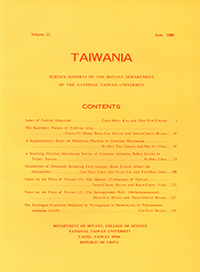Research Paper
The Secondary Forests of YenLiao Area
Chang-Fu Hsieh, Shing-Fan Huang, Tseng-Chieng Huang
Published on: March 1988
Page: 47 - 60
DOI: 10.6165/tai.1988.33.47
Abstract
The floristic differences found in the secondary forests of the Yenliao area were sampled by the placement of 35 quadrats of 10*10 m over a wide range of habitats. The present study was undertaken to (1) use both clustering and ordinations to elucidate vegetational structure and community relationships; (2) determine the principal factors controlling or closely related with forest composition; (3) evaluate the successional status of the forests. About 221 species were encountered. Vascular species richness per quadrat averaged 50. the Shannon-Wiener diversity measure of the tree stratum averaged 2.56 (natural log) and Simpson’s index (complement) averaged 0.92. Dominace is shared by Ardisia sieboldii, Ficus virgata, Cleyera japonica, Ficus fistulosa, Cyclobalanopsis glauca, Schefflera octophylla, Glochidion rubrum, and Persea thunbergii. Three major community types were defined using minimum variance cluster analysis with basal area and species cover data. The results of reciprocal averaging (RA) and principal component analysis (PCA) indicated a strong response in both quadrat and species characteristics to topographical, moisture, and oceanic complex gradients. Analysis of species compositional change across a progression of diameterbased size-strata has been used to reveal the successional relationships which exist between species of tree stratum. It shows a clear trend toward dominance by Bridelia balansae, Persea thunbergii, Ardisia sieboldii and Schefflera octophylla in the near future. Besides, the relative density data for each species’ size class were determined, and three population structure patterns were recognized.
中文摘要
為調查鹽寮地區的次生林,總共設置了35樣區,每一樣區之大小為10*10 m 。研究之目的為:(1)利用歸類集散不法以說明直被組成與植物社會之關係;(2)探討影響森林組成之主要環境因子;(3)評估森林演替之狀況。 全部樣區計含維管束植物221種,平均每一樣區種樹為50。木本層歧異度指數之平均為2.56(自然對數),而指數(互補數)之平均為0.92。森林之優勢數種為樹杞、鳥榕、楊桐、水同木、青剛櫟、江某、細葉饅頭果及紅楠等。依據胸高直徑及種覆蓋度進行最小變異歸屬分佈,其結果顯示三種主要社會類型。對應分析及主成分分析的結果則顯示樣區組成與地形、水文及海洋等因子有所關連。 利用木本層中每一種在各樹幹直徑級間的數量變化狀況以評定個數種間之演替關係。其結果顯示三類族群結構,同時在沒有遭到人為及自然破壞之下,最近未來的森林將以刺杜密、紅楠、樹杞及江某等為優勢種。


